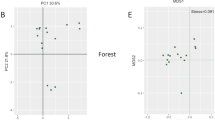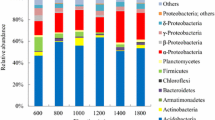Abstract
Spatial scaling to some extent determines biodiversity patterns in larger organisms, but its role in microbial diversity patterns is much less understood. Some studies have shown that bacterial community similarity decreases with distance, whereas others do not support this. Here, we studied soil bacterial communities of tropical rainforest in Malaysia at two spatial scales: a local scale with samples spaced every 5 m over a 150-m transect, and a regional scale with samples 1 to 1,800 km apart. PCR-amplified soil DNA for the bacterial 16S rRNA gene targeting the V1–V3 region was pyrosequenced using Roche/454 GS FLX Titanium platform. A ranked partial Mantel test showed a weak correlation between spatial distance and whole bacterial community dissimilarity, but only at the local scale. In contrast, environmental distance was highly correlated with community dissimilarity at both spatial scales, stressing the greater role of environmental variables rather than spatial distance in determining bacterial community variation at different spatial scales. Soil pH was the only environmental parameter that significantly explained the variance in bacterial community at the local scale, whereas total nitrogen and elevation were additional important factors at the regional scale. We obtained similar results at both scales when only the most abundant OTUs were analyzed. A variance partitioning analysis showed that environmental variables contributed more to bacterial community variation than spatial distance at both scales. In total, our results support a strong influence of the environment in determining bacterial community composition in the rainforests of Malaysia. However, it is possible that the remaining spatial distance effect is due to some of the myriad of other environmental factors which were not considered here, rather than dispersal limitation.





Similar content being viewed by others
References
Huston MA (1994) Biological diversity: the coexistence of species on changing landscapes. Cambridge University Press, Cambridge, p 708
Bell G (2001) Ecology - neutral macroecology. Science 293(5539):2413–2418
Condit R, Pitman N, Leigh EG, Chave J, Terborgh J, Foster RB, Nunez P, Aguilar S, Valencia R, Villa G, Muller-Landau HC, Losos E, Hubbell SP (2002) Beta-diversity in tropical forest trees. Science 295(5555):666–669
Koleff P, Lennon JJ, Gaston KJ (2003) Are there latitudinal gradients in species turnover? Glob Ecol Biogeogr 12(6):483–498
Qian H, Ricklefs RE (2007) A latitudinal gradient in large-scale beta diversity for vascular plants in North America. Ecol Lett 10(8):737–744
Green J, Bohannan BJM (2006) Spatial scaling of microbial biodiversity. Trends Ecol Evol 21(9):501–507
Martiny JBH, Bohannan BJM, Brown JH, Colwell RK, Fuhrman JA, Green JL, Horner-Devine MC, Kane M, Krumins JA, Kuske CR, Morin PJ, Naeem S, Ovreas L, Reysenbach AL, Smith VH, Staley JT (2006) Microbial biogeography: putting microorganisms on the map. Nat Rev Microbiol 4(2):102–112
Nemergut DR, Costello EK, Hamady M, Lozupone C, Jiang L, Schmidt SK, Fierer N, Townsend AR, Cleveland CC, Stanish L, Knight R (2011) Global patterns in the biogeography of bacterial taxa. Environ Microbiol 13(1):135–144
Roesch LF, Fulthorpe RR, Riva A, Casella G, Hadwin AKM, Kent AD, Daroub SH, Camargo FAO, Farmerie WG, Triplett EW (2007) Pyrosequencing enumerates and contrasts soil microbial diversity. ISME J 1(4):283–290
Bardgett RD, Freeman C, Ostle NJ (2008) Microbial contributions to climate change through carbon cycle feedbacks. ISME J 2(8):805–814
Baas-Becking LGM (1934) Geobiologie of inleiding tot de milieukunde. Van Stockum WP & Zoon NV, The Hague
Franklin RB, Mills AL (2003) Multi-scale variation in spatial heterogeneity for microbial community structure in an eastern Virginia agricultural field. FEMS Microbiol Ecol 44(3):335–346
Cho JC, Tiedje JM (2000) Biogeography and degree of endemicity of fluorescent Pseudomonas strains in soil. Appl Environ Microbiol 66(12):5448–5456
Horner-Devine MC, Lage M, Hughes JB, Bohannan BJ (2004) A taxa–area relationship for bacteria. Nature 432(7018):750–753
Fierer N, Jackson RB (2006) The diversity and biogeography of soil bacterial communities. Proc Natl Acad Sci U S A 103(3):626–631
Angel R, Soares MIM, Ungar ED, Gillor O (2010) Biogeography of soil archaea and bacteria along a steep precipitation gradient. ISME J 4(4):553–563
Rousk J, Baath E, Brookes PC, Lauber CL, Lozupone C, Caporaso JG, Knight R, Fierer N (2010) Soil bacterial and fungal communities across a pH gradient in an arable soil. ISME J 4(10):1340–1351
Griffiths RI, Thomson BC, James P, Bell T, Bailey M, Whiteley AS (2011) The bacterial biogeography of British soils. Environ Microbiol 13(6):1642–1654
Tripathi BM, Kim M, Singh D, Lee-Cruz L, Lai-Hoe A, Ainuddin A, Go R, Rahim RA, Husni M, Chun J (2012) Tropical soil bacterial communities in Malaysia: pH dominates in the equatorial tropics too. Microb Ecol 64(2):474–484
Lauber CL, Hamady M, Knight R, Fierer N (2009) Pyrosequencing-based assessment of soil pH as a predictor of soil bacterial community structure at the continental scale. Appl Environ Microbiol 75(15):5111–5120
Green JL, Holmes AJ, Westoby M, Oliver I, Briscoe D, Dangerfield M, Gillings M, Beattie AJ (2004) Spatial scaling of microbial eukaryote diversity. Nature 432(7018):747–750
Telford RJ, Vandvik V, Birks HJB (2006) Dispersal limitations matter for microbial morphospecies. Science 312(5776):1015–1015
Chytrý M, Lososová Z, Horsák M, Uher B, Čejka T, Danihelka J, Fajmon K, Hájek O, Juřičková L, Kintrová K (2012) Dispersal limitation is stronger in communities of microorganisms than macroorganisms across Central European cities. J Biogeogr 39(6):1101–1111
Myers N (1988) Threatened biotas: “hot spots” in tropical forests. Environmentalist 8(3):187–208
McGregor GR, Nieuwolt S (1998) Tropical climatology: an introduction to the clmates of the low latitudes, 2nd edn. Wiley, Chichester
Walsh RPD, Newbery DM (1999) The ecoclimatology of Danum, Sabah, in the context of the world’s rainforest regions, with particular reference to dry periods and their impact. Phil Trans R Soc B-Biol Sci 354(1391):1869–1883
Chun J, Kim KY, Lee JH, Choi Y (2010) The analysis of oral microbial communities of wild-type and toll-like receptor 2-deficient mice using a 454 GS FLX titanium pyrosequencer. BMC Microbiol 10:101
Schloss PD, Westcott SL, Ryabin T, Hall JR, Hartmann M, Hollister EB, Lesniewski RA, Oakley BB, Parks DH, Robinson CJ, Sahl JW, Stres B, Thallinger GG, Van Horn DJ, Weber CF (2009) Introducing mothur: open-source, platform-independent, community-supported software for describing and comparing microbial communities. Appl Environ Microbiol 75(23):7537–7541
Kim OS, Cho YJ, Lee K, Yoon SH, Kim M, Na H, Park SC, Jeon YS, Lee JH, Yi H, Won S, Chun J (2012) Introducing EzTaxon-e: a prokaryotic 16S rRNA gene sequence database with phylotypes that represent uncultured species. Int J Syst Evol Microbiol 62:716–721
Huse SM, Welch DM, Morrison HG, Sogin ML (2010) Ironing out the wrinkles in the rare biosphere through improved OTU clustering. Environ Microbiol 12(7):1889–1898
Edgar RC, Haas BJ, Clemente JC, Quince C, Knight R (2011) UCHIME improves sensitivity and speed of chimera detection. Bioinformatics 27(16):2194–2200
Logares R, Lindström ES, Langenheder S, Logue JB, Paterson H, Laybourn-Parry J, Rengefors K, Tranvik L, Bertilsson S (2013) Biogeography of bacterial communities exposed to progressive long-term environmental change. ISME J 7:937–948
Oksanen J, Kindt R, Legendre P, O’Hara B, Stevens MHH, Oksanen MJ, Suggests M (2007) Vegan: community ecology package. R package version 1.8-5. http://cran.r-project.org/ (accessed 10 April 2007)
Goslee SC, Urban DL (2007) The ecodist package for dissimilarity-based analysis of ecological data. J Stat Softw 22(7):1–19
Legendre P, Lapointe FJ, Casgrain P (1994) Modeling brain evolution from behavior — a permutational regression approach. Evolution 48(5):1487–1499
Peres-Neto PR, Legendre P, Dray S, Borcard D (2006) Variation partitioning of species data matrices: estimation and comparison of fractions. Ecology 87(10):2614–2625
Borcard D, Legendre P (2002) All-scale spatial analysis of ecological data by means of principal coordinates of neighbour matrices. Ecol Model 153(1):51–68
Borcard D, Legendre P, Avois-Jacquet C, Tuomisto H (2004) Dissecting the spatial structure of ecological data at multiple scales. Ecology 85(7):1826–1832
Blanchet FG, Legendre P, Borcard D (2008) Forward selection of explanatory variables. Ecology 89(9):2623–2632
Wagner HH (2004) Direct multi-scale ordination with canonical correspondence analysis. Ecology 85(2):342–351
R Core Team (2012) R: a language and environment for statistical computing. R Foundation for Statistical Computing, Vienna
Pasternak Z, Al-Ashhab A, Gatica J, Gafny R, Avraham S, Minz D, Gillor O, Jurkevitch E (2013) Spatial and temporal biogeography of soil microbial communities in arid and semiarid regions. Plos One 8(7):e69705
Martiny JB, Eisen JA, Penn K, Allison SD, Horner-Devine MC (2011) Drivers of bacterial beta-diversity depend on spatial scale. Proc Natl Acad Sci U S A 108(19):7850–7854
Gilbert B, Lechowicz MJ (2004) Neutrality, niches, and dispersal in a temperate forest understory. Proc Natl Acad Sci U S A 101(20):7651–7656
Campbell BJ, Polson SW, Hanson TE, Mack MC, Schuur EA (2010) The effect of nutrient deposition on bacterial communities in Arctic tundra soil. Environ Microbiol 12(7):1842–1854
Wessén E, Hallin S, Philippot L (2010) Differential responses of bacterial and archaeal groups at high taxonomical ranks to soil management. Soil Biol Biochem 42(10):1759–1765
Singh D, Takahashi K, Kim M, Chun J, Adams JM (2012) A hump-backed trend in bacterial diversity with elevation on Mount Fuji, Japan. Microb Ecol 63(2):429–437
Jones RT, Robeson MS, Lauber CL, Hamady M, Knight R, Fierer N (2009) A comprehensive survey of soil acidobacterial diversity using pyrosequencing and clone library analyses. ISME J 3(4):442–453
Pedrós-Alió C (2006) Marine microbial diversity: can it be determined? Trends Microbiol 14(6):257–263
Chesson PL, Warner RR (1981) Environmental variability promotes coexistence in lottery competitive-systems. Am Nat 117(6):923–943
Hubbell SP (2001) The unified neutral theory of biodiversity and biogeography. Princeton University Press, Princeton
Tuomisto H, Ruokolainen K, Yli-Halla M (2003) Dispersal, environment, and floristic variation of western Amazonian forests. Science 299(5604):241–244
Oh YM, Kim M, Lee-Cruz L, Lai-Hoe A, Go R, Ainuddin N, Rahim RA, Shukor N, Adams JM (2012) Distinctive bacterial communities in the rhizoplane of four tropical tree species. Microb Ecol 64(4):1018–1027
Morley RJ (2000) Origin and evolution of tropical rainforests. Wiley, Chichester
Acknowledgments
Jonathan Adams was funded by a Brain Gain grant from the Government of Malaysia and by an SNU New Faculty Research Grant. This work was partly supported by a grant from the National Research Foundation (NRF) grant funded by the Korean government, Ministry of Education, Science and Technology (MEST) (NRF-2013-031400). We are grateful to the anonymous reviewers for their help in improving the manuscript.
Author information
Authors and Affiliations
Corresponding author
Electronic supplementary material
Below is the link to the electronic supplementary material.
ESM 1
(XLSX 19 kb)
Rights and permissions
About this article
Cite this article
Tripathi, B.M., Lee-Cruz, L., Kim, M. et al. Spatial Scaling Effects on Soil Bacterial Communities in Malaysian Tropical Forests. Microb Ecol 68, 247–258 (2014). https://doi.org/10.1007/s00248-014-0404-7
Received:
Accepted:
Published:
Issue Date:
DOI: https://doi.org/10.1007/s00248-014-0404-7




